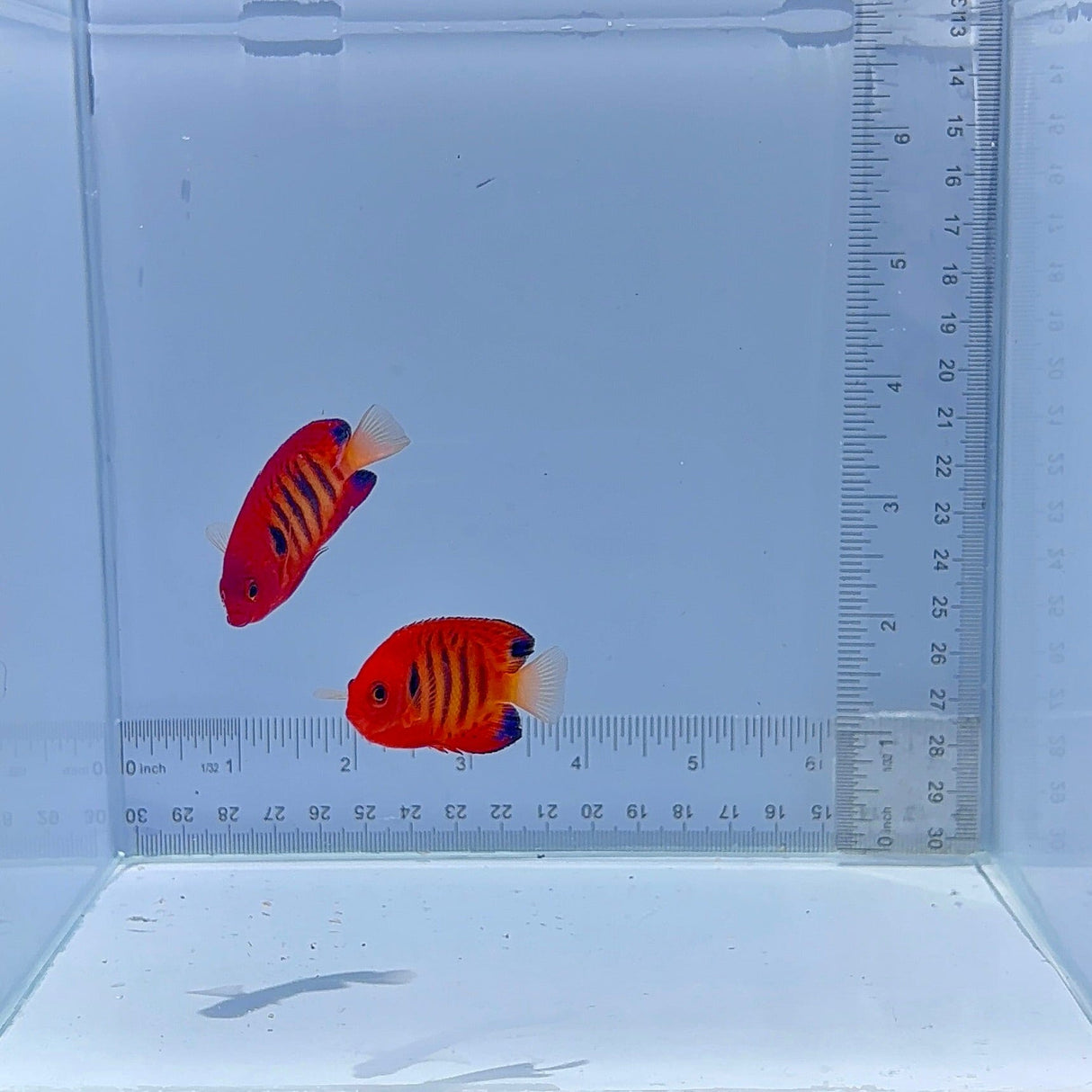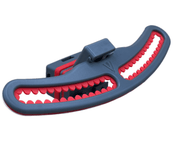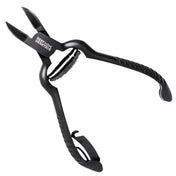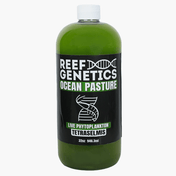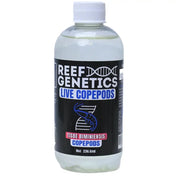Approx. Size:
Small: Up to 1.75 Inches
Regular: 1.75–2.5 Inches
Large: 2.5+ Inches
Flame Dwarf Angelfish (Centropyge loricula)
The Flame Dwarf Angelfish is a reef favorite, ablaze with bright orange-red coloration, vertical black bars, and electric blue edging along its fins. Native to the coral-rich reefs of the Central and Western Pacific, this compact angelfish combines bold color with a confident, lively personality. It’s a stunning centerpiece for tanks where beauty meets movement.
Tank Requirements
A minimum of 30 gallons is recommended, though larger systems help reduce territorial behavior. Provide plenty of live rock for grazing, hiding, and establishing territory. This species thrives in stable, mature aquariums with good water quality and moderate flow. A secure lid is ideal, as dwarf angels may occasionally dash or dart when startled.
Color, Personality, and Hardiness
Few fish match the visual impact of a healthy Flame Angel. Their fiery color glows under aquarium lighting, and their curious, interactive behavior keeps them front and center. Generally hardy and well-suited to captivity, they may show minor aggression toward similar-shaped fish, especially other dwarf angels. Once acclimated, they’re active, confident, and full of personality.
Diet and Feeding
Flame Angels are omnivores with a need for both meaty fare and marine algae. Feed a varied diet including spirulina, marine algae sheets, high-quality angelfish pellets, mysis shrimp, and finely chopped seafood. Offer multiple small meals daily to support vibrant coloration and overall health.
Tankmates and Behavior
Best kept with peaceful to semi-aggressive tankmates. May show territorial behavior toward similar species or fish with similar coloration, especially in smaller tanks. Caution is advised in reef tanks: while many individuals leave corals alone, some may nip at fleshy LPS, clams, and zoanthids. Keep well-fed and observe carefully in mixed reef systems. Generally safe with inverts and not a threat to shrimp or crabs.
At Top Shelf Aquatics, we take pride in ensuring your order arrives safely and in perfect condition. Here’s everything you need to know about our shipping process:
Livestock Shipping Details
- Flat Rate Shipping:
- $39.99 Out of State
- $34.99 Florida (In-State)
- Orders over $299 ship FREE!
- NO FREE Shipping during Sale Events
- Shipping Days: The calendar during checkout determines when your livestock order will arrive. Normally we ship Monday - Thursday via FedEx Priority Overnight.
Orders placed by 2 PM EST Monday - Thursday ship the same day. Orders placed after 2 PM or on Fridays will ship the next business day. - Delivery Times: Most packages arrive by 10:30 AM EST, though remote areas may experience later deliveries.
We take every measure to protect your livestock, including specialized packaging to maintain temperature and safety during transit.
Dead on Arrival (DOA) Policy
In the rare event of a DOA, you must submit a DOA Request within 2 hours of delivery (FedEx posted time). Once submitted, we will issue a replacement or store credit for the livestock. Please note:
- Shipping costs are not included in the credit.
- Refunds are not offered for livestock or shipping.
While we cannot be held responsible for delays caused by mechanical or weather issues, rest assured we’ll do everything possible to make it right!
Reef Guard Protection Plan
For ultimate peace of mind, upgrade to our Reef Guard Protection Plan. With Reef Guard, you’ll enjoy:
- Extended Livestock Guarantee: Coverage for up to 5 days.
- Priority Resolutions: Hassle-free claims with fast resolutions.
- Weather & Shipping Delay Coverage: Includes FedEx lost packages and damages.
Shipping Restrictions
- We currently ship livestock only within the continental U.S.
- Note: Due to Hawaii state law, we are unable to ship corals to Hawaii.
Now’s the perfect time to prepare your aquarium for its new additions. Consider doing a water change and ensuring space is ready. Check out our YouTube channel for detailed care instructions for your new corals!
For any questions or concerns, feel free to reach out to our support team. We’re here to help make your reefing journey a success!
5 Day Reef Guard
Temp-Control Box
Priority Overnight
Expert Care Support
